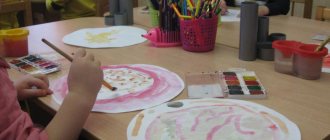Senior group. Senior preschool age. Children 5-6 years old
Consultation for parents “Game as a means of developing the legal education of children of senior preschool age” Game as a means of developing the legal education of children of senior preschool age. The consultation was prepared by : Vasilchuk S.V. educator Raising a child in accordance with the requirements of society is a necessary component of the process of preparing a person for future active...
Consultation “The Magic World of Theater” for senior preschool age Municipal “Slantsevskaya Secondary School No. 6”
preschool department
(senior preschool age)
Author of the development: teacher of the highest qualification category Andreyanova Nadezhda Petrovna, Slantsy, 2021 Introduction Relevance of problems related to moral -…
PLAN FOR INDIVIDUAL CONSULTATION WITH PARENTS, TAKEN INTO ACCOUNT OF ACHIEVEMENTS AND DIFFICULTIES IN THE CHILD’S DEVELOPMENT
PLAN FOR INDIVIDUAL CONSULTATION WITH PARENTS, TAKEN INTO ACCOUNT OF ACHIEVEMENTS AND DIFFICULTIES IN THE CHILD’S DEVELOPMENT
in the junior group of the joint venture kindergarten "Kolosok" GBOU secondary school No. 1 "OTs"
With. Bolshaya Glushitsa
developed by a student of the correspondence department of SSPK group 3B
Kondratyeva Lyubov Vladimirovna
Topic of consultation:
"Stubbornness and whims"
Purpose of consultation:
to assist parents in resolving the problem of children's whims and their stubbornness.
Tasks:
1.
Identify the causes of whims and stubbornness.
2.
Introduce mother Olga Alexandrovna to the characteristics of capricious and stubborn children;
3.
Find practical recommendations for parents on how to overcome the problem of a child’s whims and stubbornness.
4.
Increase the competence of parents in raising a child.
Sample questions for parents:
1.Are there any other children in the family?
2.Are the behavioral patterns of children in the family the same?
3. In what situations do Ivan’s whims and stubbornness most often manifest themselves?
4.What methods of interaction were used in these situations?
5.How often does the child act up?
6.What is the cause of stubbornness and whims?
7. How do you react to your child’s whims and stubbornness? What you are doing?
Practical recommendations for parents:
The first of the researchers who studied the problem of stubbornness were A. I. Zakharov, L. S. Vygotsky, Elsa Koehler, L. V. Ostrovskoy, N. L. Kryazhevoy and many other domestic and foreign scientists. Zakharov A.I. in his work “Neuroses in Children” writes that stubbornness most often occurs at the age of 1.5 to 2.5-3 and sometimes at 5 years.
The outstanding Russian psychologist Leonid Semenovich Vygotsky described the following symptoms of this crisis:
1.Negativism
– the desire to do everything the other way around, contrary to requests or demands.
A child may insist that cheese is butter, blue is green, a lion is a dog. As soon as the adult agrees with him, the child’s “opinion” can suddenly change to the opposite.
2.Stubbornness
. The child insists on his own not because he really wants it, but because he demanded it (“I want”).
Moodiness is the other side of the same behavior disorder. He understands that it is impossible, but insists (“I don’t want to”).
3.Self-will
. He wants to do everything himself, refuses help where he still knows little (“I myself”).
I offer you recommendations for overcoming stubbornness and capriciousness in children:
I offer you recommendations for overcoming stubbornness and capriciousness in children:
1. Do not attach much importance to stubbornness and capriciousness. Take note of the attack, but don't worry too much about your child.
2. During an attack, stay close to him, let him feel that you understand him.
3. Do not try to instill anything in your child at this time - it is useless. Swearing makes no sense, spanking excites him even more.
4. Be persistent in your behavior with your child; if you say “no,” continue to remain with this opinion.
5. Don’t give up even when your child has a seizure in a public place. Most often, the only thing that helps is to take him by the hand and lead him away.
6. Hysteria and capriciousness require an audience, do not resort to the help of strangers:
“Look what a bad girl she is, ah-ah-ah!” This is all the child needs.
7. Try to cheat: “Oh, what an interesting toy (book, little thing) I have!”
Such distracting maneuvers will interest the capricious person and he will calm down.
8. Eliminate from your arsenal rude tone, harshness, and the desire to “break with the power of authority.”
9. Calm tone of communication, without irritability.
10. Concessions take place if they are pedagogically appropriate and justified by the logic of the educational process.
11. Do not praise a child if: it was not achieved through one’s own labor, is not subject to praise (beauty, strength, dexterity, intelligence), out of pity or a desire to please.
12. Praise the child: for an action, for an action accomplished; always begin to cooperate with a child with praise and approval; it is very important to praise the child in the morning, as early as possible and at night too; praise without praising (example: ask for help, advice, like an adult).
13. You cannot punish or scold a child: when the child is sick, unwell, or has recovered from an illness, since at this time the child’s psyche is vulnerable and the reaction is unpredictable; when the child eats, immediately after sleep and before bedtime; in all cases when something doesn’t work out (example: when you are in a hurry and the child cannot tie his shoelaces); after physical or mental trauma (example: a child fell, you scold him for it, believing that he is to blame); when the child could not cope with fear, inattention, mobility, etc., but tried very hard; when the internal motives of his action are not clear to you; when you're not yourself.
I suggest reading works of art to solve this problem.
For example,
the fairy tale “What kind of ears does mom have?”, author Tatyana Kholkina. The purpose of the fairy tale
: 1. To overcome the cry of a child.
2. Cultivate a caring attitude towards parents. Objectives of the fairy tale:
1. Using the example of the hero of the fairy tale, show that you cannot get what you demand by shouting. 2. A polite tone is the best solution to any problem.
Fairy tale “How Andryushka planted a seed” (T. Kholkina)
not only educational in its content, but also a good example of friendship and time spent in kindergarten.
The purpose of the fairy tale:
1. To encourage the child’s desire to attend kindergarten.
2. Respect for the environment .
Objectives of the fairy tale: 1. To introduce the kindergarten regime.
2. Show the importance of friendships. You can also watch educational cartoons with your child, for example: “ Queen Toothbrush”, “In the Forest”, “Mouse’s Song”
, etc.
To solve the problem of overcoming the child’s stubbornness and whims, you can also play games, not only at home or in kindergarten, but also on the way (to kindergarten, to the store, to the dacha or somewhere else) For example, the game “Why? » (from the collection “Games and Tales that Heal” by A. V. Rudenko)
:
Purpose of the game:
1. Distract the child's attention. 2. Expand the child’s horizons of knowledge.
Game objectives:
1. Get the child interested.
Game “Trap for Caprizuli”
, you can read it, but it’s better to dramatize it when a child has a “whim” in his ear.
Purpose of the game:
1. Help the child cope with his whims.
Game objectives:
1. Overcome the child’s stubborn behavior.
Reflection
So, we have discussed with you the problem of children's whims and stubbornness.
Please tell me what you will do if your child is capricious and stubborn: he doesn’t want to leave the store and demands a new toy? What recommendation would you apply in this situation?
I would be glad if I helped you understand the situation. Thank you for your active participation in the consultation. Let's discuss changes in the child's behavior at home and in kindergarten in a week. Goodbye.
1.4. PLAN FOR INDIVIDUAL CONSULTATION WITH PARENTS, TAKEN INTO ACCOUNT OF ACHIEVEMENTS AND DIFFICULTIES IN THE CHILD’S DEVELOPMENT
Topic of consultation:
"Stubbornness and whims"
Purpose of consultation:
to assist parents in resolving the problem of children's whims and their stubbornness.
Tasks:
1.
Identify the causes of whims and stubbornness.
2.
Introduce mother Olga Alexandrovna to the characteristics of capricious and stubborn children;
3.
Find practical recommendations for parents on how to overcome the problem of a child’s whims and stubbornness.
4.
Increase the competence of parents in raising a child.
Sample questions for parents:
1.Are there any other children in the family?
2.Are the behavioral patterns of children in the family the same?
3. In what situations do Ivan’s whims and stubbornness most often manifest themselves?
4.What methods of interaction were used in these situations?
5.How often does the child act up?
6.What is the cause of stubbornness and whims?
7. How do you react to your child’s whims and stubbornness? What you are doing?
Practical recommendations for parents:
The first of the researchers who studied the problem of stubbornness were A. I. Zakharov, L. S. Vygotsky, Elsa Koehler, L. V. Ostrovskoy, N. L. Kryazhevoy and many other domestic and foreign scientists. Zakharov A.I. in his work “Neuroses in Children” writes that stubbornness most often occurs at the age of 1.5 to 2.5-3 and sometimes at 5 years.
The outstanding Russian psychologist Leonid Semenovich Vygotsky described the following symptoms of this crisis:
1.Negativism
– the desire to do everything the other way around, contrary to requests or demands.
A child may insist that cheese is butter, blue is green, a lion is a dog. As soon as the adult agrees with him, the child’s “opinion” can suddenly change to the opposite.
2.Stubbornness
. The child insists on his own not because he really wants it, but because he demanded it (“I want”).
Moodiness is the other side of the same behavior disorder. He understands that it is impossible, but insists (“I don’t want to”).
3.Self-will
. He wants to do everything himself, refuses help where he still knows little (“I myself”).
I offer you recommendations for overcoming stubbornness and capriciousness in children:
I offer you recommendations for overcoming stubbornness and capriciousness in children:
1. Do not attach much importance to stubbornness and capriciousness. Take note of the attack, but don't worry too much about your child.
2. During an attack, stay close to him, let him feel that you understand him.
3. Do not try to instill anything in your child at this time - it is useless. Swearing makes no sense, spanking excites him even more.
4. Be persistent in your behavior with your child; if you say “no,” continue to remain with this opinion.
5. Don’t give up even when your child has a seizure in a public place. Most often, the only thing that helps is to take him by the hand and lead him away.
6. Hysteria and capriciousness require an audience, do not resort to the help of strangers:
“Look what a bad girl she is, ah-ah-ah!” This is all the child needs.
7. Try to cheat: “Oh, what an interesting toy (book, little thing) I have!”
Such distracting maneuvers will interest the capricious person and he will calm down.
8. Eliminate from your arsenal rude tone, harshness, and the desire to “break with the power of authority.”
9. Calm tone of communication, without irritability.
10. Concessions take place if they are pedagogically appropriate and justified by the logic of the educational process.
11. Do not praise a child if: it was not achieved through one’s own labor, is not subject to praise (beauty, strength, dexterity, intelligence), out of pity or a desire to please.
12. Praise the child: for an action, for an action accomplished; always begin to cooperate with a child with praise and approval; it is very important to praise the child in the morning, as early as possible and at night too; praise without praising (example: ask for help, advice, like an adult).
13. You cannot punish or scold a child: when the child is sick, unwell, or has recovered from an illness, since at this time the child’s psyche is vulnerable and the reaction is unpredictable; when the child eats, immediately after sleep and before bedtime; in all cases when something doesn’t work out (example: when you are in a hurry and the child cannot tie his shoelaces); after physical or mental trauma (example: a child fell, you scold him for it, believing that he is to blame); when the child could not cope with fear, inattention, mobility, etc., but tried very hard; when the internal motives of his action are not clear to you; when you're not yourself.
I suggest reading works of art to solve this problem.
For example,
the fairy tale “What kind of ears does mom have?”, author Tatyana Kholkina. The purpose of the fairy tale
: 1. To overcome the cry of a child.
2. Cultivate a caring attitude towards parents. Objectives of the fairy tale:
1. Using the example of the hero of the fairy tale, show that you cannot get what you demand by shouting. 2. A polite tone is the best solution to any problem.
Fairy tale “How Andryushka planted a seed” (T. Kholkina)
not only educational in its content, but also a good example of friendship and time spent in kindergarten.
The purpose of the fairy tale:
1. To encourage the child’s desire to attend kindergarten.
2. Respect for the environment .
Objectives of the fairy tale: 1. To introduce the kindergarten regime.
2. Show the importance of friendships. You can also watch educational cartoons with your child, for example: “ Queen Toothbrush”, “In the Forest”, “Mouse’s Song”
, etc.
To solve the problem of overcoming the child’s stubbornness and whims, you can also play games, not only at home or in kindergarten, but also on the way (to kindergarten, to the store, to the dacha or somewhere else) For example, the game “Why? » (from the collection “Games and Tales that Heal” by A. V. Rudenko)
:
Purpose of the game:
1. Distract the child's attention. 2. Expand the child’s horizons of knowledge.
Game objectives:
1. Get the child interested.
Game “Trap for Caprizuli”
, you can read it, but it’s better to dramatize it when a child has a “whim” in his ear.
Purpose of the game:
1. Help the child cope with his whims.
Game objectives:
1. Overcome the child’s stubborn behavior.
Reflection
So, we have discussed with you the problem of children's whims and stubbornness.
Please tell me what you will do if your child is capricious and stubborn: he doesn’t want to leave the store and demands a new toy? What recommendation would you apply in this situation?
I would be glad if I helped you understand the situation. Thank you for your active participation in the consultation. Let's discuss changes in the child's behavior at home and in kindergarten in a week. Goodbye.
Materials for the parent's corner in the preschool educational institution - information in the parent's corner
Materials for the parent's corner in a preschool educational institution - information in the parent's corner
And now, let's figure out what information can be placed in the parent's corner. Remember that it should be presented as positively, clearly and, if possible, in not very large volumes. It is unlikely that parents will stand near the stand for a long period of time; they should see a short and informative message in front of them. It is also important to take into account that when placing printed information on a stand, it is necessary to indicate the authorship, date of publication of the material, and, if available, a link to the website, so that you can familiarize yourself with the material in full.
Materials for the parent corner in the preschool educational institution - information in the parent corner:
- Materials about the physical development of children
- Materials about the mental development of children
- Materials about aesthetic education
- Materials about developmental features
- Materials about health, ways to improve your health
- Materials about self-care skills
- Materials about planned classes
- Materials about children's literature
- Materials about music and musical works
- Materials about teaching methods for preschoolers
- Materials about the seasons
- Materials on speech development
- Advice from psychologists, speech therapists, pediatricians
- Thematic materials - New Year, March 8, Easter, February 23
Decorating a parent's corner in a kindergarten locker room - educational material
Decorating a parent's corner in the kindergarten locker room:
Decorating a parent's corner in the kindergarten locker room
Decorating a parent's corner in the kindergarten locker room
Decorating a parent's corner in the kindergarten locker room
Decorating a parent's corner in the kindergarten locker room
Decorating a parent's corner in the kindergarten locker room
Decorating a parent's corner in the kindergarten locker room
Decorating a parent's corner in the kindergarten locker room
Decorating a parent's corner in the kindergarten locker room
Decorating a parent's corner in the kindergarten locker room
Decorating a parent's corner in the kindergarten locker room








